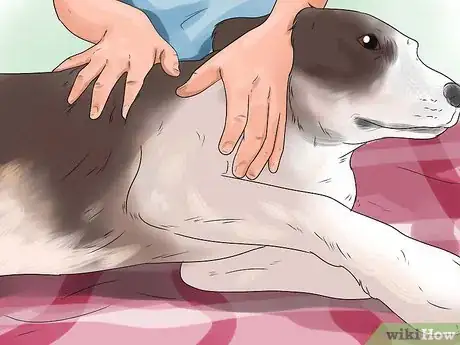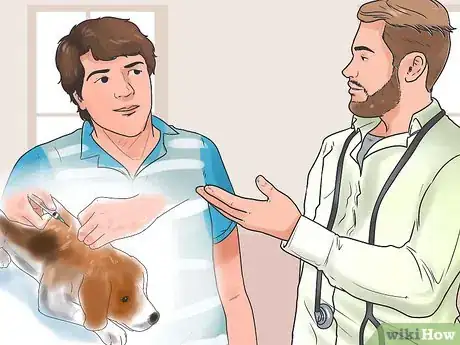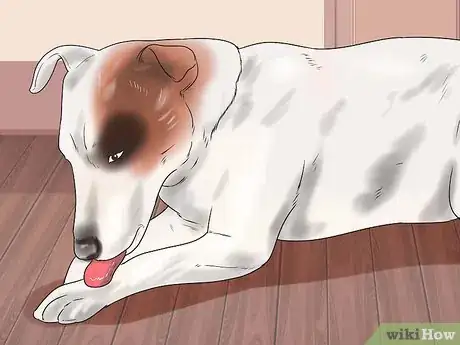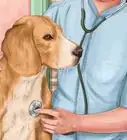This article was co-authored by Pippa Elliott, MRCVS and by wikiHow staff writer, Jessica Gibson. Dr. Elliott, BVMS, MRCVS is a veterinarian with over 30 years of experience in veterinary surgery and companion animal practice. She graduated from the University of Glasgow in 1987 with a degree in veterinary medicine and surgery. She has worked at the same animal clinic in her hometown for over 20 years.
There are 8 references cited in this article, which can be found at the bottom of the page.
wikiHow marks an article as reader-approved once it receives enough positive feedback. In this case, 94% of readers who voted found the article helpful, earning it our reader-approved status.
This article has been viewed 294,102 times.
Canine epilepsy is hard on your dog’s health and hard on you as well. Epilepsy means that your dog suffers from repeated seizures.[1] A seizure is the result of a burst of electrical energy in the brain. Some dogs will only have one seizure and never have another one, while others will have repeated seizures. It is crucial to your dog to see a veterinarian if he suffers from seizures. Seizures may become more severe without veterinary intervention. To help a dog with epilepsy, you can do several things, including supporting your dog during the episode, getting your dog the help he needs after an episode, and taking steps to help prevent further seizures.
Steps
Helping Your Dog During a Seizure
-
1Comfort your dog. Your dog is going to be scared and confused during and after a seizure, so it is crucial to do everything that you can to help them feel less afraid. If your dog suffers from frequent seizures, you will also want to learn how to recognize the signs of a seizure so that you can prepare. Some simple steps that you can take to comfort your dog during a seizure include:[2]
- Placing a cushion or pillow beneath your dog’s head. This will help to protect your dog's head during a seizure.
- Speaking to your dog in a low, soothing voice. Say things like, "It's okay, buddy. That's a good dog. Easy, easy, I got you."
- Petting your dog in a calming, gentle way. You may also consider letting your dog lay across your lap or holding them if they are a small dog.
-
2Keep your hands out of your dog’s mouth. It is a misconception that dogs will swallow their tongues, and under no circumstances should you stick your hand or fingers into your dog's mouth when they are having a seizure. You will likely get bit. Do not try to put any objects into your dog’s mouth either or your dog may break a tooth or even choke.[3]Advertisement
-
3Soothe your dog after the seizure. It is important to get your dog calmed before taking any other action. Sometimes the seizure will restart if your dog is very nervous and/or tries to get up before they have recovered. Continue soothing your dog and stay close for a while after the episode.[4]
- To help your dog relax, keep the room quiet. Turn off the radio and TV and don’t allow more than one or two people in the room. Take other pets out of the room as well.
-
4Pay attention to the duration of your dog’s seizures. Try to keep track of how long the seizures last. If your phone is handy take a video of the event. This documentation may help the veterinarian to diagnose and properly treat your dog.
- If the seizure continues for longer than five minutes, get your pet to a veterinary emergency room as quickly as possible. Long seizures can exhaust the respiratory muscles and, thereby, interfere with your dog's ability to breathe.[5]
Treating Your Dog After a Seizure
-
1Take your dog to see a veterinarian. Once the seizure is over, it is important to take your dog to the veterinarian for an examination. This examination will consist of numerous tests to rule out other causes of seizures, which will help your veterinarian to determine the best treatment option for your dog. If these tests are all negative, then your dog may be suffering from primary seizure disorder and your veterinarian will discuss medications with you.
-
2Ask about medications. There are several medications available that can help reduce both the number and the severity of seizures. Most of these medications need to be administered daily and will need to be continued for the rest of your dog’s life. The primary options include:[6] [7]
- Imepitoin. This is a new medication and has replaced phenobarbital as the treatment of choice. It reaches therapeutic blood levels faster than other medications, quickly suppressing seizures by returning the brain to equilibrium.
- Phenobarbital. This is another common medication used for dogs with epilepsy. It works by suppressing seizure activity in the brain.
- Potassium bromide. This drug is used if phenobarbital causes health problems. Sodium bromide may be used as an alternative to potassium bromide. They both decrease seizure activity in the brain.
- Gabapentin. This antiepileptic drug is commonly combined with another medication to help control generalized seizures.
- Diazepam. This drug is commonly used as a sedative instead of a regular drug to control seizures, but it may be used if your dog’s seizures are frequent and long-lasting.
- Phenytoin (Dilantin). Other drugs may be more effective and have fewer side-effects.[8] Talk to your vet about potentially prescribing this drug.
-
3Expect sedative effects. Most anti-epileptic drugs will cause some sedation early on, but most dogs will adjust to this sedative effect. Sometimes, too, combination drug therapy can help lessen sedation if your dog seems to react strongly to one medication.
- Keep in mind that medication may affect your dog's liver and kidneys, so you should weigh the cost/benefit of treatment versus coping with the occasional seizure.
-
4Talk to your veterinarian about sedating your dog during stressful situations. If your dog is very high strung, you may have to use sedatives to prevent seizures during times of stress. Talk to your veterinarian about giving your dog an occasional sedative for these stressful situations.[9]
- You may want to sedate your dog on holidays when fireworks are used, such as Independence Day in the USA and Bastille Day in France and other countries.
- You may also want to sedate your dog if you expect to have a house full of visitors and your dog is stressed by strangers.
- Even during thunderstorms, you may need to tranquilize your dog to get them through the frightening noises and flashes of light.
-
5Monitor your dog’s condition. Canine epilepsy, while controllable in most dogs, is often a progressive problem. Even with medication, some dogs may continue to have seizures now and then. If episodes become more frequent or severe, consult your dog’s veterinarian immediately.[10]
- Keep in mind that as your dog gets older, seizures and episodes can become more frequent and severe.
Learning About Canine Epilepsy
-
1Understand the types of epilepsy. Dogs suffer from two main types of epilepsy: primary and secondary.
- Primary epilepsy tends to strike young dogs (under two years of age) as it is a genetic disorder. Sometimes, though, primary epilepsy manifests as late as age 6.[11] This condition is also known as idiopathic epilepsy.
- Secondary epilepsy may occur at any age. This type of epilepsy is often due to another problem that affects the neurological system, such as an infection, a disease, a brain injury, a stroke, or brain tumor.[12]
-
2Know how to identify a grand mal seizure. In a grand mal seizure, the dog falls to its side and becomes rigid while thrashing their limbs. It may howl, salivate, bite, urinate and/or defecate during the seizure, which can last from 30 seconds to 2 minutes or more. Keep in mind that not all dogs have grand mal seizures. Some dogs may have less severe and less obvious seizures.[13]
-
3Identify a focal seizure. Some dogs may suffer from seizure that prompt them to move in a strange way or do something repetitive such as licking, walking in a circle, or listing to the side. Pay attention to any unusual behavior that your dog displays. If you are unsure if this behavior is a seizure or not, talk to your veterinarian.[14] Here, again, video footage can help your vet arrive at an accurate diagnosis
-
4Watch for signs of an oncoming seizure. Prior to a seizure, your dog may sense that something isn't right and begin to react. You may notice your dog doing certain things before a seizure such as:[15]
- Acting clingy
- Pacing
- Whining
- Vomiting
- Looking dazed or confused
Expert Q&A
-
QuestionMy dog is on phenobarbitone and acts drunk. Is this normal?
 Pippa Elliott, MRCVSDr. Elliott, BVMS, MRCVS is a veterinarian with over 30 years of experience in veterinary surgery and companion animal practice. She graduated from the University of Glasgow in 1987 with a degree in veterinary medicine and surgery. She has worked at the same animal clinic in her hometown for over 20 years.
Pippa Elliott, MRCVSDr. Elliott, BVMS, MRCVS is a veterinarian with over 30 years of experience in veterinary surgery and companion animal practice. She graduated from the University of Glasgow in 1987 with a degree in veterinary medicine and surgery. She has worked at the same animal clinic in her hometown for over 20 years.
Veterinarian One of the side effects of phenobarb is that it causes poor coordination, making the dog walk in a drunken manner. This is more common when the dog starts meds or has a dose increase. It often takes several days, but most dogs acclimate to the new dose and the wobbliness wears off. If it doesn't, then your vet may want to run tests to check on the levels of the drug in the dog's bloodstream.
One of the side effects of phenobarb is that it causes poor coordination, making the dog walk in a drunken manner. This is more common when the dog starts meds or has a dose increase. It often takes several days, but most dogs acclimate to the new dose and the wobbliness wears off. If it doesn't, then your vet may want to run tests to check on the levels of the drug in the dog's bloodstream. -
QuestionMy dog's had 3 seizures in the past few weeks and is acting weird. What should I do?
 Pippa Elliott, MRCVSDr. Elliott, BVMS, MRCVS is a veterinarian with over 30 years of experience in veterinary surgery and companion animal practice. She graduated from the University of Glasgow in 1987 with a degree in veterinary medicine and surgery. She has worked at the same animal clinic in her hometown for over 20 years.
Pippa Elliott, MRCVSDr. Elliott, BVMS, MRCVS is a veterinarian with over 30 years of experience in veterinary surgery and companion animal practice. She graduated from the University of Glasgow in 1987 with a degree in veterinary medicine and surgery. She has worked at the same animal clinic in her hometown for over 20 years.
Veterinarian It's important to investigate the cause of the seizures in order to prevent them. If no cause is found, if the seizures are more frequent than once a month or severe, then starting anti-convulsant meds is advisable. All of this means a vet check is strongly advisable.
It's important to investigate the cause of the seizures in order to prevent them. If no cause is found, if the seizures are more frequent than once a month or severe, then starting anti-convulsant meds is advisable. All of this means a vet check is strongly advisable.
Warnings
- Never discontinue any prescribed course of medication without first discussing this course of action with your veterinarian.⧼thumbs_response⧽
- A seizure lasting more than 5 minutes can be life-threatening. Call your vet in the event of an extended seizure (beyond 5 minutes) and follow their advice.⧼thumbs_response⧽
References
- ↑ http://www.canine-epilepsy.net/basics/basics_index.html
- ↑ http://pets.webmd.com/dog-seizure-disorders?page=2
- ↑ http://pets.webmd.com/dog-seizure-disorders?page=2
- ↑ http://pets.webmd.com/dog-seizure-disorders?page=2
- ↑ http://pets.webmd.com/dog-seizure-disorders?page=2
- ↑ https://www.dvm360.com/view/newer-options-medically-managing-refractory-canine-epilepsy
- ↑ http://www.noahcompendium.co.uk/?id=-447733
- ↑ https://www.petcoach.co/article/phenytoin-dilantin-sup-r-sup/
- ↑ https://www.dvm360.com/view/newer-options-medically-managing-refractory-canine-epilepsy
- ↑ http://pets.webmd.com/dog-seizure-disorders
- ↑ http://vet.osu.edu/vmc/companion/our-services/neurology-and-neurosurgery/more-epilepsy
- ↑ http://www.petmd.com/dog/conditions/neurological/c_dg_epilepsy_idiopathic_genetic#
- ↑ http://pets.webmd.com/dog-seizure-disorders
- ↑ http://pets.webmd.com/dog-seizure-disorders
- ↑ http://pets.webmd.com/dog-seizure-disorders
About This Article
It can be scary and stressful if your dog has a seizure, but if your dog has canine epilepsy, there are things you can do to help it be more comfortable. When you see your dog having a seizure, try to place a pillow or a cushion beneath its head, and talk to your dog in a low, soothing voice to comfort it. However, do not stick your hand or your fingers into your dog’s mouth, as the dog might accidentally bite you. Afterward, take your dog to the veterinarian for an exam, and ask about medication that can help prevent future seizures. Keep reading for advice from our Veterinary co-author on how to identify different types of seizures in a dog!





































































